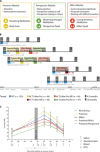Specific reduction in cortisol stress reactivity after social but not attention-based mental training
- PMID: 28983508
- PMCID: PMC5627978
- DOI: 10.1126/sciadv.1700495
Specific reduction in cortisol stress reactivity after social but not attention-based mental training
Abstract
Psychosocial stress is a public health burden in modern societies. Chronic stress-induced disease processes are, in large part, mediated via the activation of the hypothalamic-pituitary-adrenal (HPA) axis and the sympathetic-adrenal-medullary system. We asked whether the contemplative mental training of different practice types targeting attentional, socio-affective (for example, compassion), or socio-cognitive abilities (for example, perspective-taking) in the context of a 9-month longitudinal training study offers an effective means for psychosocial stress reduction. Using a multimethod approach including subjective, endocrine, autonomic, and immune markers and testing 313 participants in a standardized psychosocial laboratory stressor, we show that all three practice types markedly reduced self-reported stress reactivity in healthy participants. However, only the training of intersubjective skills via socio-affective and socio-cognitive routes attenuated the physiological stress response, specifically the secretion of the HPA axis end-product cortisol, by up to 51%. The assessed autonomic and innate immune markers were not influenced by any practice type. Mental training focused on present-moment attention and interoceptive awareness as implemented in many mindfulness-based intervention programs was thus limited to stress reduction on the level of self-report. However, its effectiveness was equal to that of intersubjective practice types in boosting the association between subjective and endocrine stress markers. Our results reveal a broadly accessible low-cost approach to acquiring psychosocial stress resilience. Short daily intersubjective practice may be a promising method for minimizing the incidence of chronic social stress-related disease, thereby reducing individual suffering and relieving a substantial financial burden on society.
Figures



Similar articles
-
Testing the monitor and acceptance theory: the role of training-induced changes in monitoring- and acceptance-related capacities after attention-based, socio-emotional, or socio-cognitive mental training in reducing cortisol stress reactivity.Stress. 2024 Jan;27(1):2345906. doi: 10.1080/10253890.2024.2345906. Epub 2024 Jun 6. Stress. 2024. PMID: 38841737
-
Reducing neuroendocrine psychosocial stress response through socio-emotional dyadic but not mindfulness online training.Front Endocrinol (Lausanne). 2024 Jun 24;15:1277929. doi: 10.3389/fendo.2024.1277929. eCollection 2024. Front Endocrinol (Lausanne). 2024. PMID: 38978617 Free PMC article. Clinical Trial.
-
Boosting recovery rather than buffering reactivity: Higher stress-induced oxytocin secretion is associated with increased cortisol reactivity and faster vagal recovery after acute psychosocial stress.Psychoneuroendocrinology. 2016 Dec;74:111-120. doi: 10.1016/j.psyneuen.2016.08.029. Epub 2016 Aug 31. Psychoneuroendocrinology. 2016. PMID: 27608360
-
The influence of sleep on human hypothalamic-pituitary-adrenal (HPA) axis reactivity: A systematic review.Sleep Med Rev. 2018 Jun;39:187-194. doi: 10.1016/j.smrv.2017.10.002. Epub 2017 Oct 18. Sleep Med Rev. 2018. PMID: 29126903 Review.
-
[Stress and psychotic transition: A literature review].Encephale. 2016 Aug;42(4):367-73. doi: 10.1016/j.encep.2015.10.001. Epub 2016 May 6. Encephale. 2016. PMID: 27161263 Review. French.
Cited by
-
The neuroscience of social feelings: mechanisms of adaptive social functioning.Neurosci Biobehav Rev. 2021 Sep;128:592-620. doi: 10.1016/j.neubiorev.2021.05.028. Epub 2021 Jun 2. Neurosci Biobehav Rev. 2021. PMID: 34089764 Free PMC article. Review.
-
Compassion protects against vital exhaustion and negative emotionality.Motiv Emot. 2021;45(4):506-517. doi: 10.1007/s11031-021-09878-2. Epub 2021 Apr 13. Motiv Emot. 2021. PMID: 34720257 Free PMC article.
-
Highlighting the Potential for Chronic Stress to Minimize Therapeutic Responses to Radiotherapy through Increased Immunosuppression and Radiation Resistance.Cancers (Basel). 2020 Dec 20;12(12):3853. doi: 10.3390/cancers12123853. Cancers (Basel). 2020. PMID: 33419318 Free PMC article. Review.
-
Reflections on the study of empathy in a sample of refugees and migrants from Arabic-speaking countries with diverse experiences of war-related trauma.Compr Psychoneuroendocrinol. 2024 Jul 23;19:100253. doi: 10.1016/j.cpnec.2024.100253. eCollection 2024 Aug. Compr Psychoneuroendocrinol. 2024. PMID: 39170081 Free PMC article. Review.
-
Differential increase of hippocampal subfield volume after socio-affective mental training relates to reductions in diurnal cortisol.Elife. 2024 Aug 28;12:RP87634. doi: 10.7554/eLife.87634. Elife. 2024. PMID: 39196261 Free PMC article.
References
-
- Sapolsky R. M., Social status and health in humans and other animals. Annu. Rev. Anthropol. 33, 393–418 (2004).
-
- Tost H., Champagne F. A., Meyer-Lindenberg A., Environmental influence in the brain, human welfare and mental health. Nat. Neurosci. 18, 1421–1431 (2015). - PubMed
-
- Chrousos G. P., Stress and disorders of the stress system. Nat. Rev. Endocrinol. 5, 374–381 (2009). - PubMed
-
- Rosch P. J., The quandary of job stress compensation. Health and Stress 3, 1–4 (2001).
Publication types
MeSH terms
Substances
Grants and funding
LinkOut - more resources
Full Text Sources
Other Literature Sources
Medical

